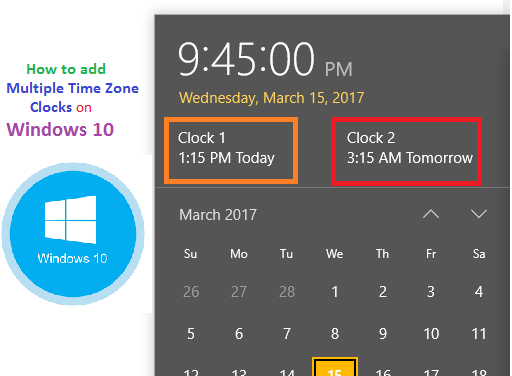Mastering Time: A Comprehensive Guide on How to Add Clocks from Multiple Time Zones in Windows 10

Introduction:
In our interconnected world, where communication and collaboration span across continents, the ability to keep track of time zones is crucial for effective planning and coordination. Windows 10, the versatile operating system from Microsoft, offers users the capability to add clocks from multiple time zones directly to the taskbar. In this extensive guide, we will delve into the reasons for adding multiple time zone clocks, step-by-step instructions on how to implement this feature, and the benefits it brings to individuals navigating the global landscape.
The Importance of Multiple Time Zone Clocks:
- Global Collaboration:
- In an era of remote work and global collaboration, individuals find themselves working with colleagues, clients, or partners located in different time zones. Multiple time zone clocks provide an immediate visual reference, facilitating efficient scheduling and coordination.
- Travel and Communication:
- For frequent travelers or those with international contacts, keeping track of multiple time zones is essential for scheduling meetings, calls, or staying connected with friends and family across the globe. Multiple time zone clocks simplify the process of managing time disparities.
- Meeting Deadlines:
- Professionals working with deadlines that span various time zones benefit from the ability to monitor the local time at key locations. This ensures timely submissions and effective project management across global teams.
Step-by-Step Guide to Add Clocks from Multiple Time Zones:
- Accessing Date and Time Settings:
- Right-click on the system clock in the taskbar and select “Adjust date/time” to access the Date & Time settings. Alternatively, go to Settings > Time & language > Date & time.
- Adding Additional Clocks:
- Within the Date & Time settings, navigate to the “Additional clocks” section. Check the box that says “Show this clock” to enable additional clocks. Here, users can choose up to two additional clocks, each associated with a specific time zone.
- Selecting Time Zones:
- Click on the drop-down menu for each additional clock to choose the desired time zone. Users can scroll through the extensive list of time zones or use the search function to quickly find the relevant location.
- Naming Additional Clocks:
- To enhance clarity, users can enter a descriptive name for each additional clock. For instance, if monitoring the time zone of a remote office, entering the city or office name as the clock’s label provides quick identification.
- Applying Changes:
- Click “Apply” and then “OK” to save the changes. The additional clocks are now visible by clicking on the system clock in the taskbar. Hovering over the clock reveals a pop-up displaying the time and date for each configured time zone.
Advanced Customization and Optimization:
- Customizing Clock Format:
- Users can customize the clock format by going to Settings > Time & language > Date & time > Change date and time formats. Here, users can choose between a 12-hour and 24-hour clock format, enhancing personalization.
- Pin Additional Clocks to Start:
- For quick access, users can pin the additional clocks to the Start menu. Right-click on the clock and select “Pin to Start” to create a direct tile for each time zone, providing immediate visibility upon opening the Start menu.
- Keyboard Shortcut for Alarms & Clock App:
- Users can quickly access the Alarms & Clock app, which displays multiple time zones, by using the keyboard shortcut “Windows key + S” and typing “Alarms.” This provides an alternative method for quick time zone reference.
Benefits of Adding Clocks from Multiple Time Zones:
- Efficient Global Coordination:
- Multiple time zone clocks on the taskbar enable efficient coordination with global teams, ensuring that meetings and collaborative efforts are scheduled at mutually convenient times.
- Time Zone Awareness for Travelers:
- For individuals who frequently travel or have international contacts, having visual access to multiple time zones simplifies the process of scheduling and staying connected across different regions.
- Enhanced Productivity:
- Professionals managing projects or deadlines across time zones benefit from the ability to monitor local times seamlessly. This leads to enhanced productivity as tasks are managed with precision and consideration for time disparities.
- Reduced Mental Load:
- Rather than mentally calculating time differences, users can rely on the immediate visual reference provided by multiple time zone clocks. This reduces cognitive load and contributes to a more organized and stress-free work environment.
Conclusion:
The addition of clocks from multiple time zones to the taskbar in Windows 10 is a feature designed to empower users in a globally connected world. As the boundaries of work and communication extend beyond local time zones, this customization offers a practical solution for individuals seeking efficient coordination, seamless scheduling, and enhanced productivity.
By following the step-by-step guide and exploring additional customization options, users can tailor their Windows 10 experience to meet the demands of a diverse and interconnected landscape. The benefits of multiple time zone clocks extend beyond practicality; they contribute to a more holistic and user-centric computing environment, aligning with the evolving needs of individuals navigating the complexities of a globalized world.




